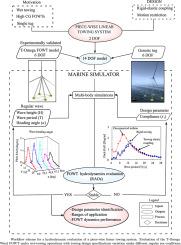浮式海上风力涡轮机(FOWTs)湿拖曳作业的新型分段线性系统
IF 4.4
2区 工程技术
Q1 ENGINEERING, OCEAN
引用次数: 0
摘要
本文评估了一种新型分段线性拖曳系统在T-Omega风力浮式海上风力涡轮机(FOWT)上的动态影响,该系统连接在拖船和风力涡轮机之间进行湿拖曳操作。这种新型的拖曳装置由两个刚性连接器组成,其中包括一个弹性联轴器,旨在减少拖轮和涡轮机之间传递的可变连接力,否则可能导致涡轮机的不良响应。为此,利用英国阿伯丁大学国家退役中心(NDC)的多物理场海洋模拟器,对规则海浪条件下的14自由度拖曳系统进行了数值模拟研究。根据波高(H)、周期(T)和入射角(α)等波浪参数的变化,对拖曳系统在“低”至“中”海况下的性能进行了评估。评估了不同拖曳系统参数(即耦合柔度,χi)和各种恒定拖曳速度(Vi)对FOWT动力学的影响。计算了系统轨迹,并对涡轮机的升沉、横摇和俯仰自由度进行了RAOs评估,结果表明,在接近俯仰共振的波浪激励周期,新系统有效地将俯仰RAOs降低了36%。此外,耦合将基音共振转移到更高的周期,这与系统刚度和波高成比例变化。当湿拖曳速度低于2.5 [m/s]时,对水轮机升沉和俯仰流体力学的影响可以忽略不计。最后,将拖曳装置的相对位移作为所施加的力的函数进行评估,以选择“低”海况下最优的装置顺应性。研究揭示了拖曳“鱼尾”等对水轮机产生的非线性影响,揭示了拖曳和环境参数对水轮机产生的强烈非线性动力学。本文章由计算机程序翻译,如有差异,请以英文原文为准。

Novel piece-wise linear system for Floating Offshore Wind Turbines (FOWTs) wet-towing operations
This paper evaluates the dynamic effects of a novel piece-wise linear towing system on the T-Omega Wind Floating Offshore Wind Turbine (FOWT), when connected between a tugboat and the wind turbine to perform wet-towing operations. The novel towing device consists on two rigid connectors that include an elastic coupling aiming to reduce variable connection forces transferred between the tug and the turbine, that could result into turbines’ undesired responses. Therefore, a numerical study of a 14 DOF towing system under regular sea waves is simulated with the state-of-art real multiphysics Marine Simulator at the National Decommissioning Centre (NDC) at the University of Aberdeen. The towing system performance is evaluated for “Low” to “Moderate” Sea States with a variation of wave parameters, such as, wave height (), period () and incident angle (). The effects on the FOWT dynamics are evaluated for different towing system parameters (i.e. coupling compliance, ) and various constant towing velocities (). System trajectories are computed and RAOs are evaluated for the turbines’ heave, roll and pitch DOF, showing that the novel system effectively reduces the pitch RAOs up to a 36% for wave excitation periods close to the pitch resonance. Moreover, the coupling shifts the pitch resonance to higher periods, which vary proportionally with the system rigidity and the wave height. The effects on turbine’s heave and pitch hydrodynamics when wet-towed at velocities lower than 2.5 [m/s] can be neglected for head seas. Finally, the towing device relative displacements are evaluated as a function of the forces applied to choose most optimal device compliance for “Low” Sea States. The study reveals some nonlinear effects induced on the turbine, such as towing “Fishtailing”, and discloses the strong nonlinear turbine dynamics induced by towing and environmental parameters.
求助全文
通过发布文献求助,成功后即可免费获取论文全文。
去求助
来源期刊

Applied Ocean Research
地学-工程:大洋
CiteScore
8.70
自引率
7.00%
发文量
316
审稿时长
59 days
期刊介绍:
The aim of Applied Ocean Research is to encourage the submission of papers that advance the state of knowledge in a range of topics relevant to ocean engineering.
 求助内容:
求助内容: 应助结果提醒方式:
应助结果提醒方式:


